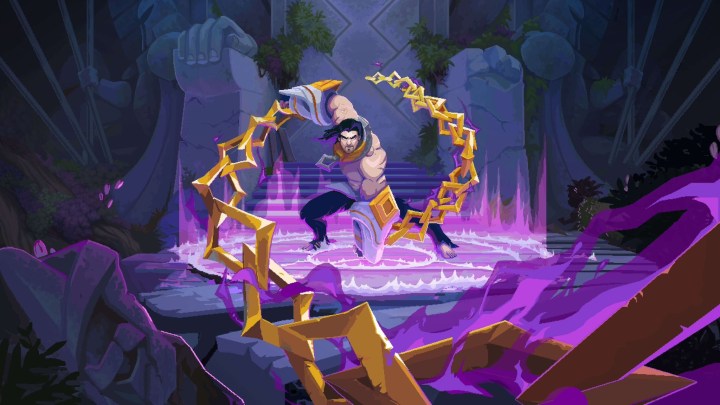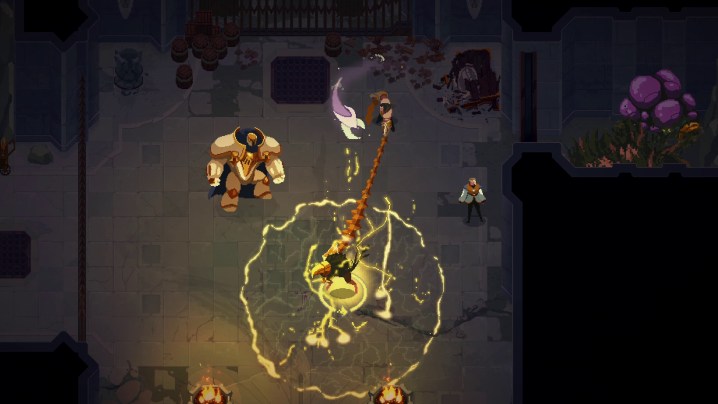When I sat down to try a demo of The Mageseeker: A League of Legends Story at PAX East, I was dropped straight into an escape mission. At first, I fumbled with switching between casting spells and dodging attacks from enemy mages. By the end, I juggled between at least four magical abilities while dashing around to survive. It was a hectic experience, but one that perfectly complemented its storytelling.
In the new League of Legends action RPG from developer Digital Sun, magic is outlawed in Demacia. Sylas, a former mage hunter with magical powers of his own, busts out of prison and starts his quest for vengeance against those who imprisoned him. The Mageseeker explores the backstory through an action RPG that faithfully builds on League of Legends lore.
Digital Sun took inspiration from games like Hyper Light Drifter, Cross Code, and Hades when creating it, and that’s very apparent based on the fast-paced gameplay I tried at PAX. On top of that, though, it doubles as an intriguing addition to the League universe for newcomers and veterans alike. Mageseeker is shaping up to be one of the best action games of the year — enough so that I’m tempted to call it Hades-level good.
Award-worthy action
Mageseeker’s complex combat system is its crown jewel. Sylas’ signature ability steals powers from enemy mages, and it can only trigger again after a brief cooldown. This limit forces players to aim spells carefully and rely on other attacks besides magic. Magic falls into one of six elements with type advantages and elemental weaknesses that developers tried to keep simple, like fire being strong against ice.
Melee attacks and evasive maneuvers round out the system. The Mageseeker gets a dash, light attack, and heavy attack that all have minimal cooldowns. The two melee attacks aren’t just the same skills with different damage outputs. They differ on both speed and range, adding another layer of strategic pacing to battles.

In addition to basic attacks, players can hold four abilities that can be freely used via D-pad. They rely on an energy meter that charges based on how often you attack enemies and objectives, though. I repeatedly slammed Sylas’ chains against a gate that the captive NPC asked me to break down, which covered all my charging needs. During the demo boss fight, I cycled between frantic dashing, timely melee attacks, and healing magic whenever I had meter.
Smart UI decisions enhance that combat flow. Each monster I faced had a clear visual cue that alerted me when it was attacking, when it was about to recover, and how to differentiate between them on a busy screen. I’d sometimes find myself in a screen full of enemies, all of them throwing magic while a boss unleashed wave after wave of devastating attacks outlined in red. When I messed up, I was always sure it was my fault and not the product of unclear game design.
All that action is responsive without feeling a step off beat, and none of the controls overlapped enough that they interfered with each other. Every maneuver felt easy to execute with the button layout, enough that I was able to choreograph my next attack at each point of the fight and effectively combo enemies.
No League necessary
Action isn’t sole focus here, though. Digital Sun knew it wanted to go with an action RPG instead of a roguelite like Moonlighter (its previous game) this time so that it could focus on story. While Hades offers an example of a satisfying story with a roguelite setup, the developers thought it would be easier for the team to strengthen the narrative in a more straightforward way. The team had the idea for a protagonist who could copy abilities for their new game without knowing that Sylas would be just around the corner. By a stroke of luck, the titular Mageseeker joined the League of Legends roster just before the team pitched the idea to Riot Forge.

Digital Sun highlighted that Mageseeker was supposed to be for everyone, even those with limited League of Legends knowledge. The RPG takes place after the events of the Lux comic, which anyone can read online for free. However, you don’t need to have context to enjoy the story or gameplay. I’m a beginner at League and didn’t have an issue picking it up during my demo. It helps that an introductory cutscene explains Sylas’ circumstances, including why he was locked in the Mageseeker compound and his reasons for seeking revenge.
Developers at PAX told Digital Trends that they prioritized treating the characters Riot made with respect, which involved heavily studying the characters to write believable scenarios and dialogue. They also carefully weighed the benefits of creating new characters to flesh out Sylas’ backstory versus bringing in existing characters from the League universe. The end goal was to create characters that would challenge Sylas and bring out different sides of his character, some of whom I met in the demo.
Based on what I’ve tried so far, Mageseeker promises to be an action-packed RPG that should appeal to both League and non-League players alike. I’m already ready to play the full 12- to 15-hour campaign when it comes out next month.
The Mageseeker: A League of Legends Story launches on April 18, 2023 for Nintendo Switch, PlayStation 4, PlayStation 5, Xbox, Xbox Series X|S, and PC via Steam.



